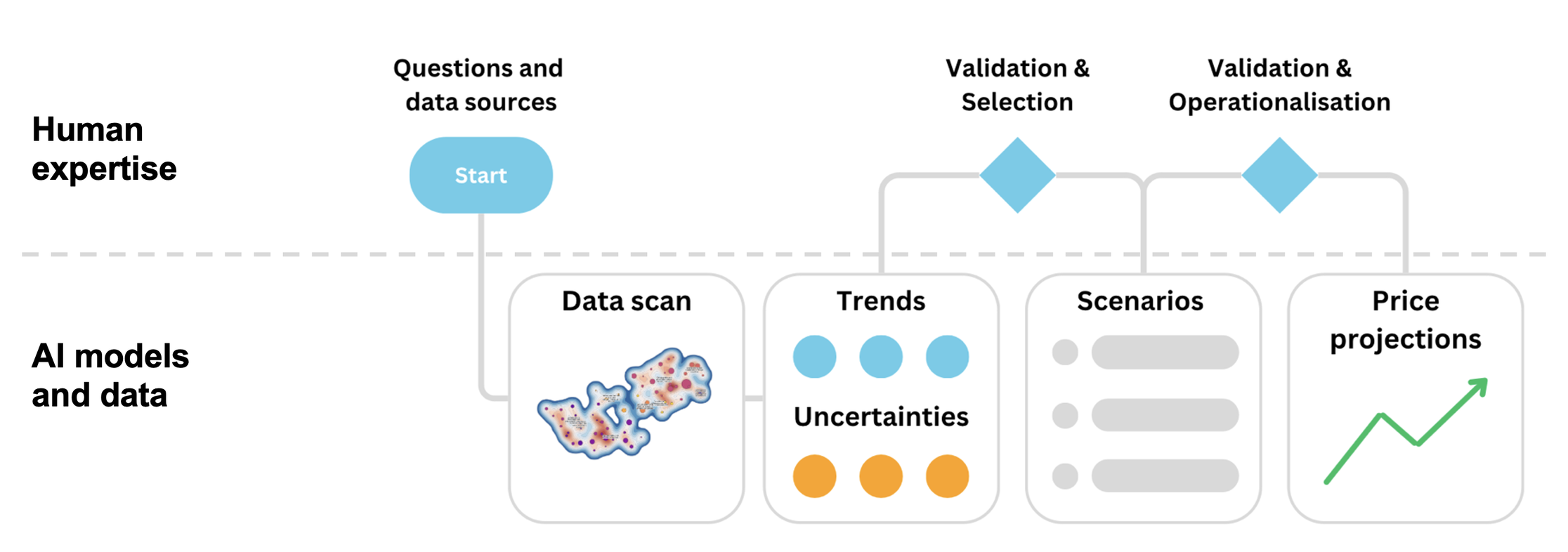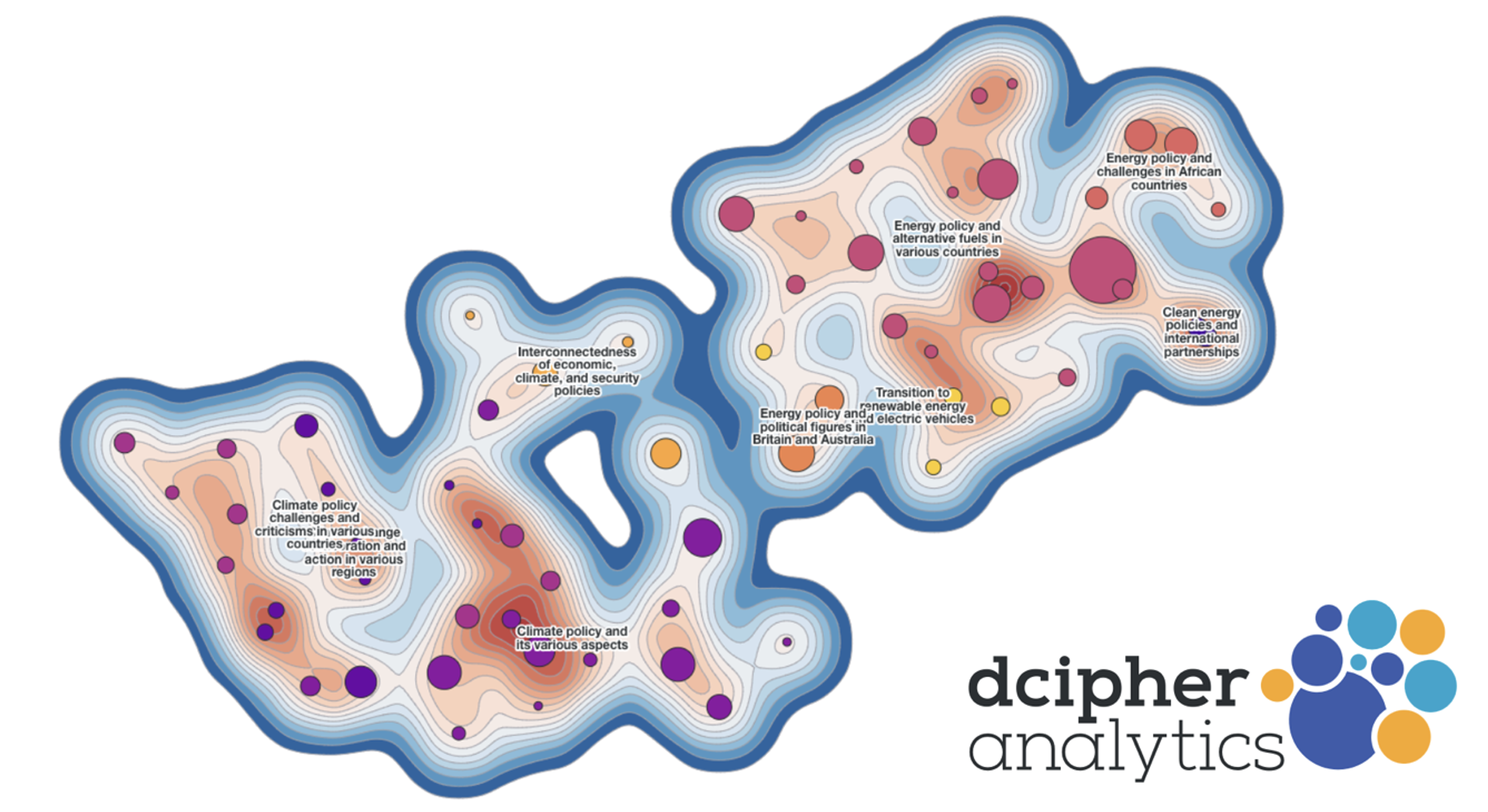The Future of Human-Machine Collaboration: Swedish Energy Scenarios Created by Human Experts and the Latest AI Models (Case Study)
In the rapidly evolving energy sector, strategic foresight is essential. In this project, we partnered with leading energy companies and consulting firm Profu to create scenarios for the future of energy markets. By integrating energy industry expertise with advanced AI tools, we developed detailed, actionable scenarios that help our clients navigate uncertainty and make informed strategic decisions.
In recent years, energy markets have been affected by different external events ranging from wars to pandemics to inflation to rapidly shifting public opinion on nuclear energy. Amid such uncertainty, awareness of the surrounding world can be the difference between survival and bankruptcy. Yet, many companies overlook investments in this area. There’s simply too much to keep track of, more than any human can handle.
In this project, we explored how to utilize generative AI to overcome this challenge. The goal was to develop 2050 scenarios for the Swedish energy markets through a collaboration between industry experts and the latest in AI. The project was a joint effort between several energy companies, Profu, another consultancy specializing in forecasting of energy prices, and Kairos Future, using our expertise in strategic foresight and our own AI platform, Dcipher Analytics.
The limitations of current gen AI
While AI can read and analyze thousands of data points in a few minutes and produce impressively well written texts, the output is often generic, contains errors and hallucinations, or misses critical information. The solution to this problem is an iterative approach between human experts and AI models, where you divide the tasks between you according to the strengths and weaknesses of each. With AI agents, the human role is transitioning into a manager, who defines and designs tasks that the AI performs, and ensures that the quality is good enough. In this project, we followed the process shown below, where the AI performs most of the work, while a team of human experts focus on validating and selecting which output to proceed with.

We used an iterative process between human experts and AI models.
Data – the single most important thing
The principle of Garbage in, Garbage out also applies to generative AI. Therefore, selecting high quality data sources is key. We used a combination of news data, reports, policy documents, academic research, startup, and investment data, covering topics from energy market specifics, to geopolitics, economy, regulations, public opinion etc. In addition to data, you need computational power and AI models. Dcipher has all the latest AI models like GPT4, Anthropic Claude, Gemini Ultra, integrated in the platform along with cloud computing power to run them.
Based on these data sources, we created dashboards with visualizations, trained research bots, and generated reports summarizing the most important trends and uncertainties shaping the future of the energy industry, with assessments of certainty, impact, and the potential consequences. This was an enormous time saver, as doing this manually would have required many hours of work.

Example dashboard based on 5,000 news articles about energy policy.
Scenario construction with AI
The output provided a starting point for the experts to validate and select what to proceed with. We selected key trends and uncertainties that we deemed most relevant to the future of the Swedish energy market. We then created scenarios that together created a reasonable range of possible outcomes.

Each scenario was described in detail by generative AI, capturing things like energy policy, energy mix, technology, investments, regulations, geopolitics, trade and many more aspects that were relevant for the business models of the energy companies in this project. Developing the consequences of a scenario for such a wide array of aspects is usually a very time-consuming task, but with the help of AI, you can get most of the work done very quickly, and instead focus on validating the output, removing inaccuracies and inconsistencies.

We validated AI generated scenario descriptions with human expertise.
Using the scenario descriptions, Profu then operationalized each scenario into assumptions for the parameters of their quantitative pricing model TIMES-NORDIC, which generated price projections for each scenario.
Project results and benefits
The results of the project were different scenarios with trends and uncertainties based on a large amount of data, with price projections to quantify the effects on energy markets. These results can now be used to inform decisions, minimize risks, manage investments, and future-proof strategies. The main benefits of using AI tools to support this kind of work is the amount of data it enables you to handle, and the time and resources it saves. It enables organizations to professionalize their strategic foresight, even for smaller companies with limited resources. However, it is still important to remember that the human expertise is what allows the end results to be reliable and useful for strategic decision making.

The Future of AI – what are the limits?
As companies invest heavily in developing advanced AI models, questions arise about its limits. The primary constraint is often the training data; the quality of an AI model is fundamentally limited by it. Moreover, our project illustrates that efficiently leveraging this technology presents another crucial challenge. Companies that recognize and develop this capability will likely outperform those that overlook its strategic value.
If you feel like you could learn how to better utilize data and AI tools, reach out to us. We have 30 years of experience working with strategic foresight, 15 years of experience of AI technology, and 5 years using our own AI platform for strategic foresight. Contact us for a first conversation about how we could help you.
